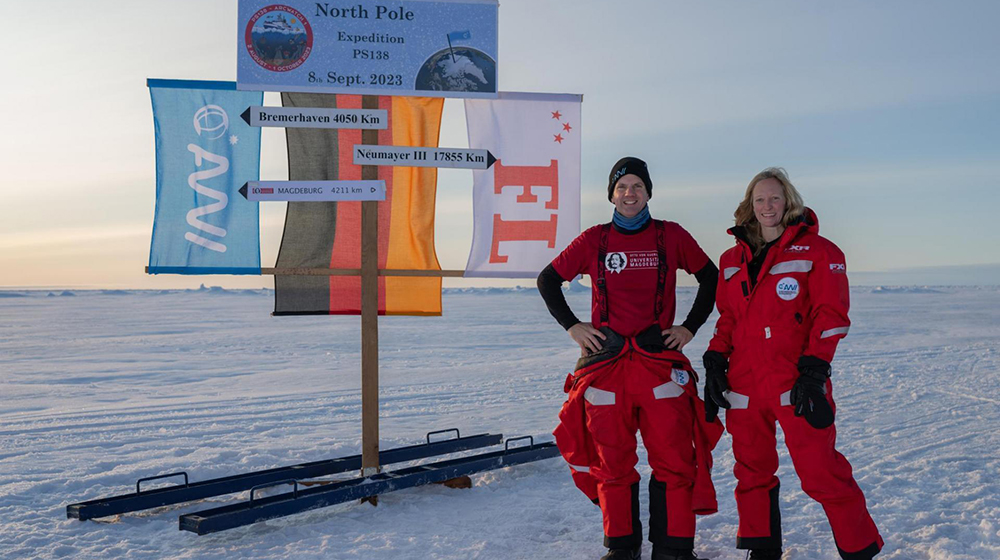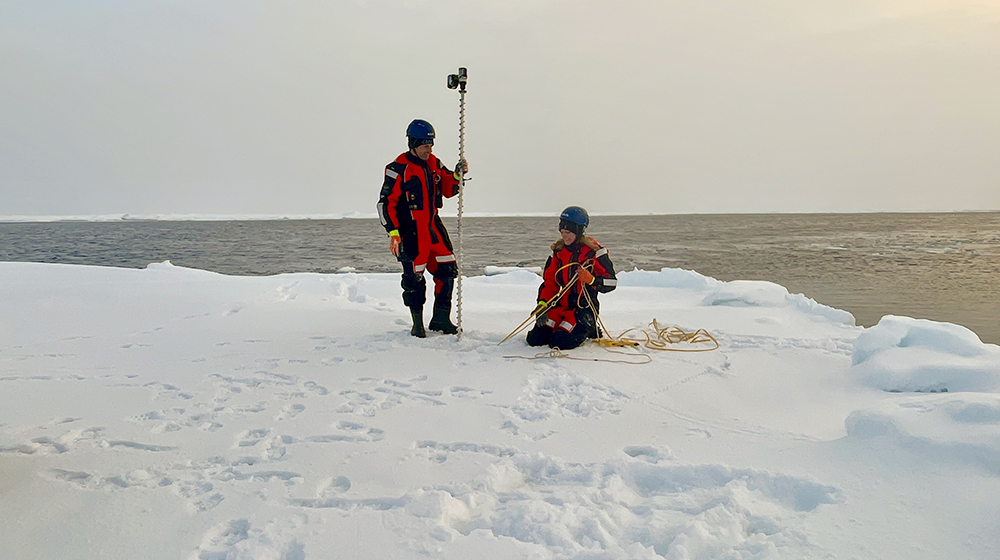
An e-mail from the Arctic Ocean is something you don't get every day: Dr. Carolin Mehlmann and Prof. Thomas Richter from the Faculty of Mathematics at Magdeburg University sent it. The two are currently on the research ship "Polarstern" from the Alfred Wegener Institute - and have been since August. Together with around 40 other researchers, the two are taking part in an expedition to the Arctic Ocean to collect data on changes in the central Arctic due to climate change. They reached the North Pole by ship in early September and report on their experiences.
"With the Polarstern, we reached the North Pole at around 8:30 in the morning of September 7, 2023. It is the seventh time for the ship. After a day of scientific investigation of the deep sea and the seafloor exactly at the pole, it went on September 8 for further investigations on the ice layer - because there is no land here. Outside it looks like the last weeks, nothing points to a special spot. Smaller and larger ice floes alternate with open areas of seawater.
Dr. Carolin Mehlmann in front of the research vessel Polarstern (Photo: Thomas Richter / Carolin Mehlmann)
Mid-September is always the period with the smallest extent of sea ice. Nevertheless: It is not normal that the North Pole is so easy to reach. In the 90s, on its first visit to the North Pole, Polarstern only managed to make its way to the pole with a second icebreaker in a laborious voyage. We managed the remaining 100 km last night with only 30 percent engine utilization. September ice extent in the Arctic has decreased by 1/3 since the 90s and there is also much less thick multi-year ice.
Mathematical laws do not apply at the North Pole
Mathematically, the North Pole is a special place. No matter in which direction we look, we always look to the south. There is only this one direction left. The day is just 24 hours long. The sun always has the same height and turns once around the horizon. There are still two weeks until sunset, then comes the long night until March. Such points, where usual rules and laws are no longer valid in the familiar way, are called singularities in mathematics. North Pole and South Pole are such singularities and they also cause a little headache in the creation of climate models.
As part of a research project, I, Prof. Thomas Richter, and my colleague Dr. Carolin Mehlmann are investigating how the greatly changed ice extent can be correctly represented in climate models. Areas where dense ice cover alternates with loose, drifting and smaller floes are becoming increasingly common. It is precisely these transition zones that Carolin Mehlmann is investigating in a project funded by the German Research Foundation. Here on board the ship, we are studying drift, i.e. the movement of small floes, and developing models of how this movement can be predicted in relation to the wind and ocean currents. Together, we automatically evaluate camera footage of the crow's nest. This is the highest accessible area on the ship, which can be reached via a kind of fire escape.
We determine the movements of a large number of floes using image recognition methods and reconcile these with the data on wind speed and ocean movement. We obtain information on the wind from the ship's meteorological system and the ocean motion is provided by the oceanographers traveling with the ship. Finally, we use mathematical optimization methods to calibrate our models, i.e., to determine missing parameters that describe, for example, the influence of wind on floe motion. To check our image recognition system, we repeatedly went out in an inflatable boat from Polarstern to measure individual small ice floes. In special survival suits we measured the size and also the thickness of the floes. To do this, we drilled once through the floe and measured the thickness with a specially prepared meter gauge: Our floe was about 7 by 9 meters and had an ice thickness of 128 cm.
 Prof. Thomas Richter and Dr. Carolin Mehlmann measure an ice floe for their calculations (Photo: Thomas Richter / Carolin Mehlmann)
Prof. Thomas Richter and Dr. Carolin Mehlmann measure an ice floe for their calculations (Photo: Thomas Richter / Carolin Mehlmann)
For our mathematical project, we are well prepared with the Magdeburg background. We both work in the research training group "Mathematical Model Reduction Math Core", which is funded by the German Research Foundation. Here we conduct research together with mathematicians from the fields of modeling, numerics, optimization and geometry. All these areas play a major role in our project."
Research project with school students
At the beginning of October, the Polarstern will return to its home port in Bremerhaven. After the expedition, the mathematician will organize a year of "Climate Change and Mathematics", in which they will explore exciting connections between mathematics and climate science with school students in a working group. Registration is already open now.
